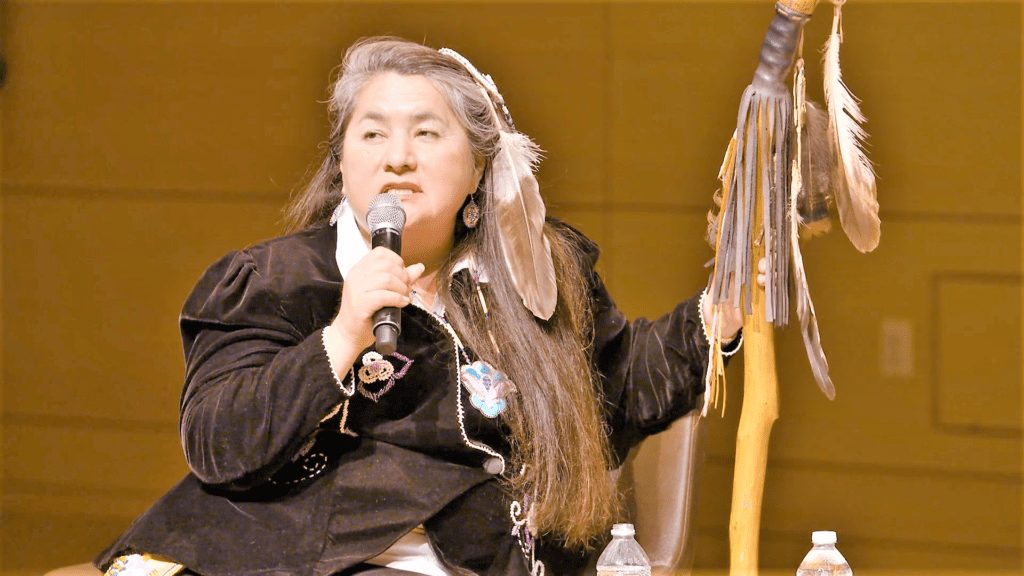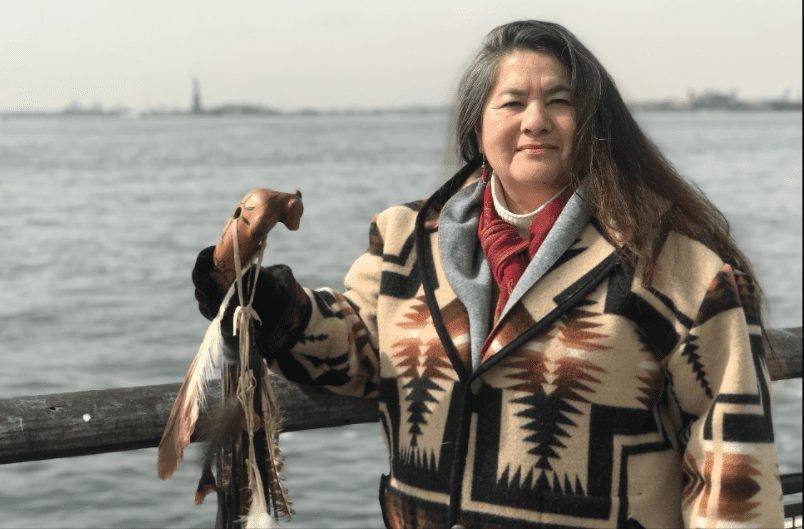
BROOKINGS, South Dakota – “My grandmother would say, “We’re not feminists, we’re the law.”
So began a film screening and discussion December 15th on indigenous women’s roles in cementing universal suffrage in the United States. It would conclude after a battery of thought-provoking reflections on gender roles in governance.
The event was the kickoff of the “Voting: Why It Matters” series of interactive public online productions being offered at no cost by the South Dakota Humanities Council, based in Brookings.
It featured the new award-winning short documentary “Without a Whisper/Konnon:Kwe,” made by Mohawk Territory producer-director Katsitsionni Fox to tell a long-unheralded story about how the
people of the matrilineal Iroquois Confederacy have been influencing public policy over time.
As the movie’s official website notes, its protagonists, Mohawk Clan Mother Louise Herne and Women’s Studies pioneer PhD Sally Roesch Wagner join forces here to “shake the foundation of the established history of the women’s rights movement in the United States.”
Together with Fox, they “shed light on the hidden history of the influence of Haudenosaunee women on the women’s rights movement, possibly changing this historical narrative forever.”
In the opening scenes, their conversation assures viewers, “It’s not about history; it’s all about herstory.”

Political science buffs are aware that the Six Nations of the Iroquois (Hodinöhsö:ni′ or Haudenosaunee), including the Mohawk Territory of Akwesasne, can claim a centuries-old form of government that inspired the language of the U.S. Constitution and the federal system of checks and balances.
Likewise, students of society’s development during the 250 years since colonization usually trace the roots of the women’s movement to the 1848 Declaration of Sentiments hammered out by suffragettes at an unprecedented civil rights convention in the hamlet of Seneca Falls.
However, the bulk of the scholarly documentation casts a blind eye to the underlying fact that women of the tribes in what is now upstate New York held and still hold the authority that instigated the turn of these events, as Roesch Wagner noted in editing the book that helped gain her a place in the film, The Women’s Suffrage Movement.
“This book doesn’t begin with white women,” feminist Gloria Steinem, who wrote the book’s forward, says at a presentation of it shown in the movie.
In fact, both the book and the movie begin with the creation story of Sky Woman, who made Turtle Island from a handful of dirt when she danced on it – a striking contrast to Judaic-Christian creation myth, in which woman is formed from a rib of a man.
“When you take away the concept of God the Father, the white guy in the sky, and replace it with the sacredness in the Earth … instead of placing people up here and other animals down here…,” Roesch Wagner said, the effect is remarkable.
Haudenosaunee women are role model
The early-day settlers of upstate New York were impressed in many ways by their native counterparts, being moved to utopian quests for everything from abolition of slavery to integrated food systems, not only democratic governance and gender equality, she found.
“Man didn’t create the Earth; woman did,” Herne said. “That set in motion, we are women of the law. The continuous flow of the generations maintains that maternal order. Clan mothers have the right of nomination of their leaders, the right of recall for any shenanigans, the right to declare war. They have their hands on the national treasury and the food supply. They decide how many babies will be born in a year.”
Haudenosaunee women’s traditional role includes planting and harvesting, along with responsibility for community organization, while men’s domain is “the woods,” the film’s protagonists explain. French explorers and early Jesuit missionaries who had early contact with Haudenosaunee communities marveled at the women’s strength and ease in childbirth, attributing it to ignorance of the Christian Bible while summoning up ideas of how to exert supremacy, the viewer learns.
In marriage, the Haudenosaunee husband traditionally moves into the longhouse of the wife’s clan. If he misbehaves, the wife puts his belongings outside, a custom that astounded 19th Century women’s rights and suffrage movement leader Elizabeth Cady Stanton, according to Roesch Wagner.
At the time, Euro-American women became men’s property at marriage, could not own anything, divorce or sue, and had no place in the halls of governance, as detailed in the Seneca Falls declaration.

When founding fathers of the United States Thomas Jefferson and Benjamin Franklin saw the Iroquois clan mothers in action, they dubbed the Native generals, “petticoat chiefs”, wondering why the men would confer with the women when making political decisions, Roesch Wagner noted.
Being as it was, Haudenosaunee women had no call to clamor for equal rights or voting parity with men, the film explains. Even after the 72-year struggle for Euro-American women to obtain at least enough legal status to vote, Haudenosaunee citizens remained skeptical of taking part in the balloting system, Herne said.
Later, when Native people became United States citizens and voters in 1924, she observed, it was not by consent, rather an arbitrary decision by those in power. “I always tell people don’t vote,” she said.
She called to mind the Haudenosaunee Two-Row Wampum Belt that signifies an agreement in a 17th Century treaty with Dutch settlers to stay out of each other’s boats. To assert sovereignty, the rule of thumb since then has been “not to be involved and not to take part in the other system, or it will sink our canoe,” she said.
She did, however, concede that 2020 elections were heavily influenced by a successful Native vote drive, and with recent wins in U.S. elected posts resulting in more Native women participating in government process, “it’s real important there is presence there.”

Time to restore balance
Herne sees “Without a Whisper/Konnon:Kwe” as a tool for restoring balance lost due to society’s failure to take into account the contributions of Native women.
“This film will now awaken all those voiceless ancestors who went to their graves unheard,” she said. Through this film, because of our invisibility, we’re hoping the erasure of indigenous people stops and that our voices are heard, and we are listened to, because we’ve been screaming for a long time.”
From the Haudenosaunee perspective, “the continuity of the law is grounded in the status or well-being of the mother. The condition of the globe right now is because we have disregarded her for so long, she said, adding that violence against the Earth is violence against women. When there is an assault on the Earth, its usually the indigenous women who say, ‘You can’t do that,” she said.
“As we move forward and we kick down the door, you better align yourself with an indigenous woman somewhere, because if anybody can read the Earth, we still know how. If there is going to be any reversal in the train wreck we’re heading for, it’s going to be found in an indigenous woman in this hemisphere.”
She added, “We’re all in this together and we’re all related.”
Director Fox encouraged viewers to take that message to heart. “One of our most important teachings is our opening address,” she noted. “We give thanks to everything in the natural world and acknowledge all those things every day in ceremony.
“If everybody would do that, and not just say the words, something everybody can do is be reverent — and that changes things.”
Roesch Wagner had another piece of advice for those who seek unity through reconciliation. She said for her, the process involves “living my life as a recovering racist; learning appreciation, not appropriation.”
The discussion is recorded for public access on social media.
The film, facilitated by Executive Producer Shirley Sneve at Vision Maker Media, is being aired by Public Broadcasting Services. It premiered in November at the Red Lake Film Festival, where it won the award for best short documentary, and has been honored at nine other independent film festivals.
Fox hopes schools will use it widely. For more information, visit the production’s official website.

“This book doesn’t begin with white women,” feminist Gloria Steinem, who wrote the book’s forward, says at a presentation of it shown in the movie.
An earlier version of this story previously appeared in Native Sun News Today.
Documentary films Haudenosaunee Irquois Confederacy Katsitsionni Fox women's movement